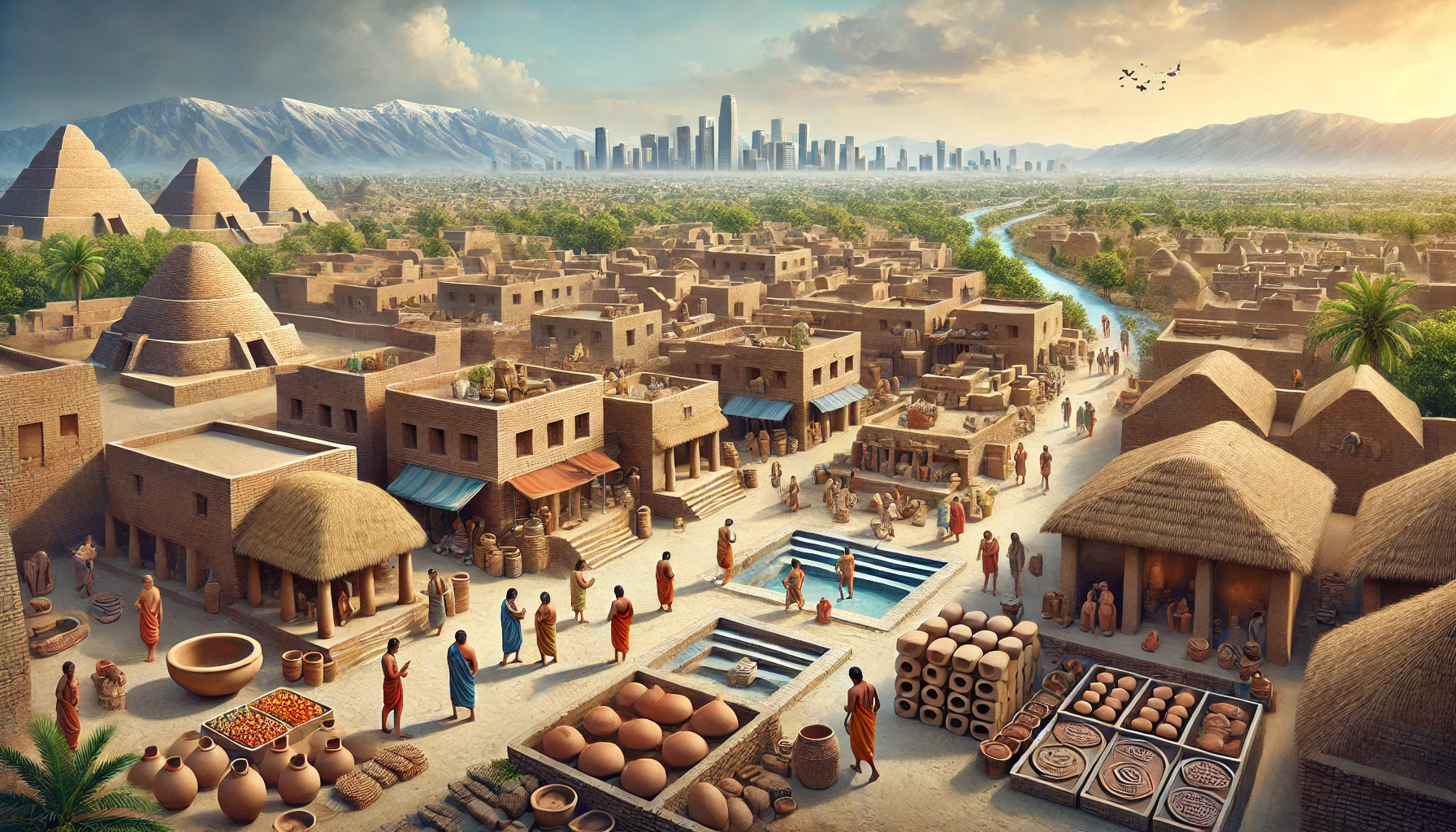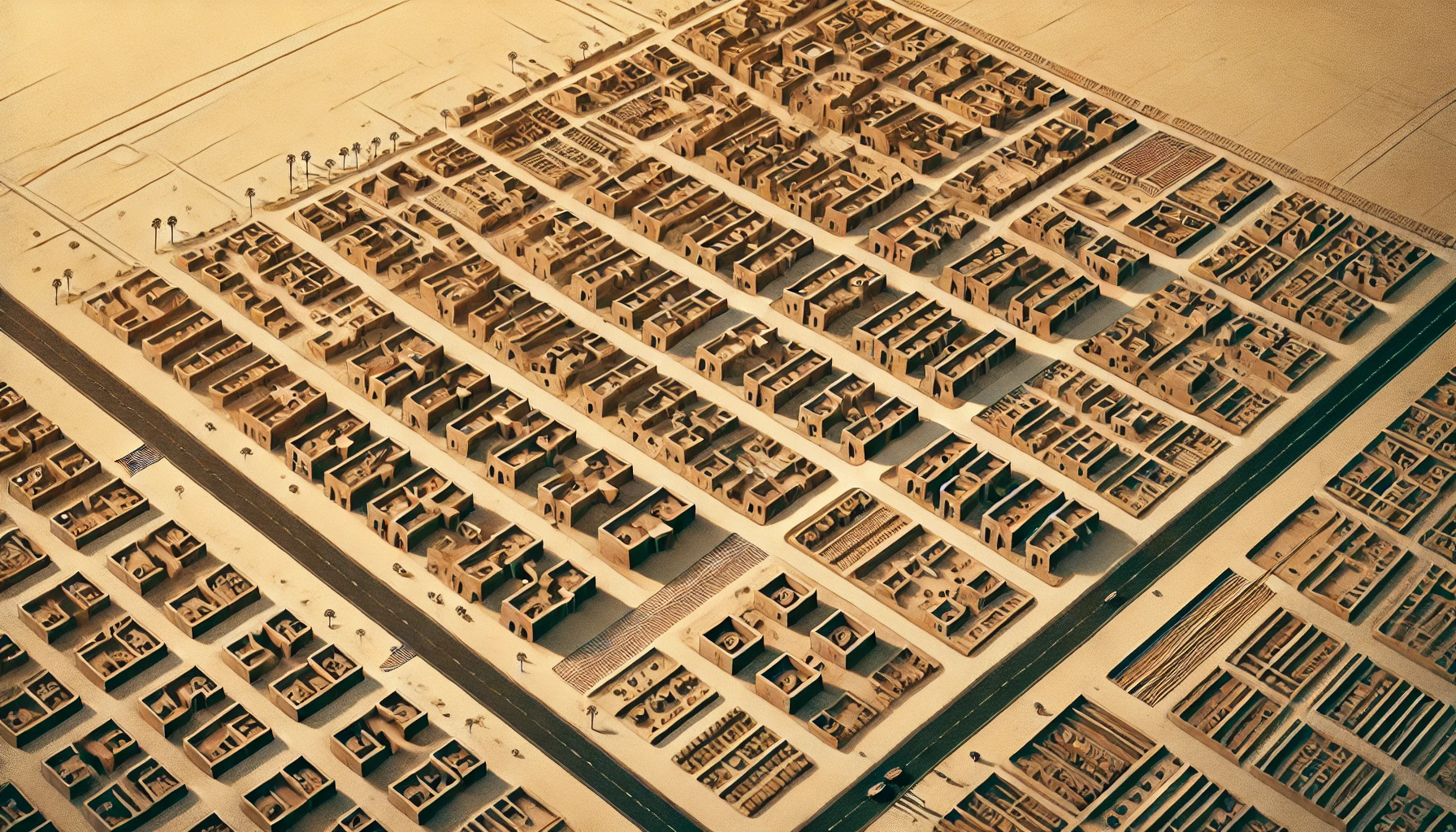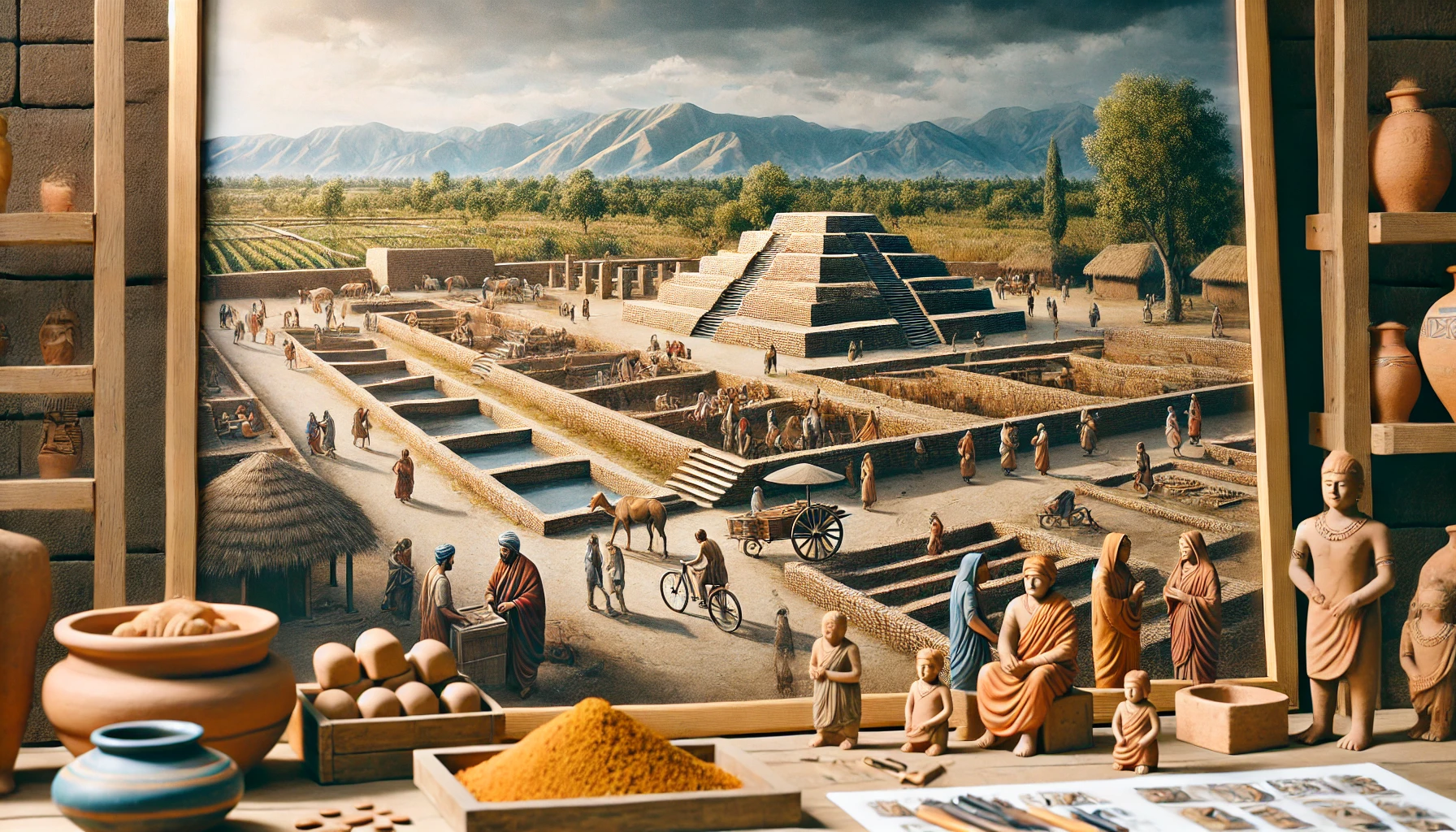The Indus Valley Civilization, also known as the Harappan Civilization, is one of the world’s earliest urban cultures. It flourished around 3300 BCE–1300 BCE in what is now Pakistan and northwest India. This ancient civilization is renowned for its advanced city planning, remarkable architecture, and sophisticated drainage systems. It showcases a high degree of social and technological development.
Key Indus Valley civilization sites like Harappa, Mohenjo-Daro, and Dholavira exhibit a level of planning and organization that was unparalleled at the time. These cities featured grid layouts, standardized bricks, and elaborate drainage systems, reflecting a strong central authority and meticulous urban governance. The civilization’s script, which remains undeciphered, suggests a complex and rich communication system, pointing to an advanced socio-economic structure.
Despite its remarkable achievements, the Indus Valley Civilization’s decline around 1900 BCE remains a subject of debate among historians. Various theories, including environmental changes, tectonic activities, and invasions, have been proposed to explain its mysterious disappearance. The study of this ancient civilization provides valuable insights into the early development of human societies and their interaction with the environment.

Historical Context and Discovery
The Indus Valley Civilization (IVC), dating back to around 3300 BCE, is one of the world’s earliest urban cultures. It is primarily located in present-day Pakistan and northwest India. Its historical significance lies in its advanced urban planning, architecture, and social organization. The discovery of the IVC began in the 1920s at Harappa and Mohenjo-Daro by archaeologists like Sir John Marshall. The findings revealed a sophisticated and widespread civilization. They challenged previous notions about ancient societies and highlighted the complexity of early human history in the Indian subcontinent.
Chronology and Geographical Spread
The Indus Valley civilization was primarily located in the Indus River valley, with its major urban centers at Harappa and Mohenjo-Daro. It extended over a vast area, from Balochistan to Gujarat, with more than 1,000 towns and villages. The civilization is typically divided into three phases: the Early Harappan(3300 to 2600 BCE), Mature Harappan(2600-1900 BCE), and Late Harappan(1900-1300 BCE) phases.
Discovery and Excavation
The ruins of the civilization were first identified by Charles Masson in 1826. The systematic excavations began much later in the 1920s by Sir John Marshall. He discovered the great cities of Harappa and Mohenjo-Daro, revealing a civilization of immense complexity and technological advancement.
Town Planning of Indus Valley Civilization
The Indus Valley Civilization is renowned for its advanced urban planning and architecture. Cities like Harappa and Mohenjo-Daro were laid out in a grid pattern. They featured wide streets and well-planned residential and public areas. Buildings were constructed with standardized baked bricks, showcasing remarkable uniformity. Notable architectural achievements include sophisticated drainage systems, with covered drains and sewage facilities, and impressive public structures like the Great Bath of Mohenjo-Daro. The uniformity and precision in urban planning reflect a highly organized central authority and an advanced understanding of civil engineering and urban governance.
Features of Indus Valley Civilization: Urban Planning
The Indus Valley Civilization is known for its advanced urban planning and architecture. The cities were characterized by:
- Grid Layout: Streets and buildings were arranged in a grid pattern, suggesting advanced urban planning and civil engineering.
- Drainage System: An impressive drainage system with covered sewers that ran alongside the streets, showing concern for sanitation and public health.
- Standardized Construction: The use of standardized fired bricks in the construction of buildings and drains.
Major Architectural Finds
- The Great Bath of Indus Valley civilization: Likely used for ceremonial or hygienic purposes, this well-built structure. It highlights the civilization’s architectural sophistication.
- Granaries of Indus Valley civilization: Large granaries found at Harappa indicate the management of grain and a complex food storage system. They are essential for urban centers.
- Citadel of Indus Valley civilization: Situated in Mohenjo-daro’s western region, is a huge artificial hill constructed entirely of bricks. It is thought to have functioned as a center for religious and political formation.

Socio-Economic Structure
The Indus Valley Civilization is renowned for its advanced urban planning and architecture. Cities like Harappa and Mohenjo-Daro were laid out in a grid pattern, featuring wide streets and well-planned residential and public areas. Buildings were constructed with standardized baked bricks, showcasing remarkable uniformity. Notable architectural achievements include sophisticated drainage systems, with covered drains and sewage facilities, and impressive public structures like the Great Bath of Mohenjo-Daro. The uniformity and precision in urban planning reflect a highly organized central authority and an advanced understanding of civil engineering and urban governance.
Economy and Trade
The economy of the Indus Valley civilization was predominantly based on agriculture, supplemented by trade. Mainly including:
- Agricultural Practices: Evidence suggests the cultivation of wheat, barley, and pulses. They also domesticated animals such as cattle, sheep, and goats.
- Trade and Commerce: The civilization engaged in local as well as long-distance trade, with links to Mesopotamia. It is evident from the discovery of Indus seals and weights which were standardized across the region.
Art and Culture
The artistic expressions of the Indus people are found in their:
- Seals: Made from steatite, these seals often depict animals and geometric patterns and are thought to have been used for trade and administrative purposes.
- Pottery and Beadwork: Red pottery with black designs is characteristic, and finely crafted beadwork suggests a rich craft tradition.
Religious and Social Practices
The religious and social practices of the Indus Valley Civilization (IVC) remain partially speculative due to the undeciphered script. However, archaeological evidence suggests a polytheistic belief system, possibly worshipping a Mother Goddess and a male deity resembling Shiva. Numerous terracotta figurines, seals depicting animals, and ritual objects indicate the presence of religious rituals. The social structure appears to have been egalitarian, with evidence of trade, craft specialization, and a standardized system of weights and measures. Public baths like the Great Bath of Mohenjo-Daro hint at ritualistic cleansing practices. It highlights the civilization’s emphasis on purity and communal activities.
Religious Beliefs
While there is no definitive evidence of a central religious authority or temples, numerous artifacts, including terracotta figurines and seals. It suggests that the people worshiped nature, animals, and possibly mother goddesses.
Social Structure
The lack of showy palaces or royal tombs suggests a more egalitarian social structure compared to other ancient civilizations. The uniformity in the size and quality of the houses across cities indicates a lack of marked social stratification.

Decline and Legacy
The decline of the Indus Valley Civilization around 1900 BCE remains a topic of scholarly debate. Theories include environmental changes, such as climate shifts and river drying, as well as potential invasions or internal social disruptions. Despite its decline, the legacy of the IVC is profound and it influenced subsequent cultures in the Indian subcontinent. Its advancements in urban planning, architecture, and social organization set foundational precedents for future societies. The civilization’s standardized weights and measures, craft techniques, and trade networks highlight its contribution to economic and cultural development. It leaves a lasting imprint on the region’s historical and cultural fabric.
Theories of Decline
Several theories have been proposed regarding the decline of the Indus Valley Civilization:
- Ecological Changes: Changes in climate and river courses might have led to agricultural difficulties.
- Invasions: Some scholars suggest invasions by nomadic tribes may have played a role.
Impact and Legacy
Despite its decline, the technological and urban innovations of the Indus Valley Civilization laid foundational concepts for urban planning and architecture. It significantly influenced subsequent cultures in the region.
Relevance
The Indus Valley Civilization (IVC) is vital in ancient Indian history, providing insights into early urbanization, social organization, and economic practices. Understanding the IVC enhances appreciation of India’s cultural heritage, crucial for General Studies Paper I. Knowledge of key archaeological sites like Harappa and Mohenjo-Daro is frequently tested. The IVC’s advanced urban planning and architecture offer lessons for civil engineering and urban governance, relevant to General Studies Paper III. Its environmental adaptation provides case studies for geography and environmental science. Studying the IVC aids in understanding the continuity and transformation of Indian civilization, fostering critical analysis and historical research skills.
| Indus Valley Civilization UPSC Notes |
| 1. Indus Valley Civilization (IVC) emerged around 3300 BCE in the northwestern regions of South Asia, particularly in present-day Pakistan and northwest India. It is one of the world’s earliest urban civilizations alongside Mesopotamia and Ancient Egypt. 2. The IVC had advanced urban planning, with cities like Harappa and Mohenjo-Daro showcasing grid patterns, well-laid streets, and sophisticated drainage systems. 3. Its architecture included well-built houses made of baked bricks, multi-storied buildings, public baths, granaries, and fortified administrative or religious centers. 4. The economy was primarily agrarian, supplemented by trade and commerce. They cultivated wheat, barley, peas, and cotton and engaged in trade with Mesopotamia and other distant regions. 5. The script of the Indus Valley Civilization, which remains undeciphered, suggests a complex system of writing used for administrative and possibly religious purposes. 6. Artifacts such as seals, pottery, beads, and terracotta figurines indicate a high level of craftsmanship and aesthetic sense, reflecting the civilization’s cultural richness. 7. The decline of the Indus Valley Civilization around 1900 BCE is attributed to various factors, including environmental changes, such as climate shifts leading to droughts and floods, and possibly the invasion by Aryans. 8. The legacy of the IVC includes its contributions to urban planning, architecture, and craftsmanship, which influenced subsequent cultures in the Indian subcontinent. |

